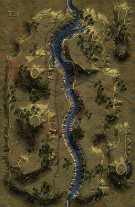| Author |
JayTownsend
|
| Method |
Solo |
| Victor |
United States |
| Play Date |
2017-05-19 |
| Language |
English |
| Scenario |
KWCA025
|
Korean War: Counter-Attack, scenario #25: Battle Mountain
Ok, finally after years of waiting I got to play a finished version from Counter-Attack. For the life of me, I couldn’t decide which scenario to play first, so I picked a medium size one mapper that only has one battle in the divided battle-packs. It has the NKPA attacking American Army units on Old Baldy or Bald Peak or lastly, Battle Mountain and this gets fought over again in latter Korean conflicts/games.
The Americans start dug-in and I placed them on the larger, northern 40-meter hill and conceded the lone southern 40-meter hex giving or spotting the North Koreans a two point advantage to start the game, as I didn’t want to spread my American units out that much and there are far many more northern 40-meter hill hex points to fight over. The American drew one excellent Capt. Leader but two bad Lt Leader counters one of the bunch and the rest average. The NKPA drew one excellent Capt. One bad LT and the rest were average Leader counters. The North Korean units of from the 6th Division enter their main force from the south to avoid the gorge terrain as much as possible but also a small force from the west just to occupy the Americans attention from the main attack a bit. There is no NKPA armor, vehicles or bunkers to keep the American 3.5in Bazooka team busy in this scenario but it does stack for free and will add one point to any assault factor attacks, which can’t hurt, as I know those NKPA will try and swarm the dug-in American Infantry.
The first few turn are mostly the NKPA using the early hours and terrain to close into the American positions. Once daylight hits, things start to heat up with a good dose of American artillery on the advancing North Koreans. The American rolled incredible off-board artillery and on board mortar dice rolls. I mean like: 12, 11, 2, 3 in the first four turns. I almost gave up and started over but didn’t and rolled a few good dice for the NKPA off-board artillery, recovered some demoralized and disputed units and closed in the American positions so I didn’t reset. First the NKPA flanking units overran the American supporting mortar units on an adjacent 20-meter hill and found a method to close with the larger, heavily defended 40-meter mountain by send the 4-2 Infantry units first to absorb the hits so the 6-1 SMG units can get adjacent to hopefully active first the next turn and use direct fire on adjacent units or assault them, depending on the odds and situation. If the risk was worth it, I would even stack three NKPA units together to get higher results, with any combination of INF, SMG, HMG & ATR units.
The NKPA started to roll hot dice for a while and back and forth the battle went, and I wasn’t sure who would win, as the NKPA get two points for certain 40-meter hill hexes while the American only get one point each for the same hexes, kind of balancing out their loses as the assaulting playing usually always has higher loses in this hilly terrain.
Towards the end, a kind of stalemate happened but figuring the victory conditions, the American lost 7 steps while the NKPA lost 11 steps. The American gained 6 points of 40-meter hexes and the NKPA gained 6 points of 40-meter hill hexes as well. But the total points for the American is 17 to the NKPA 13, giving the Americans a Minor Victory by one point. A closer game then I thought and I am glad I didn’t restart it. I good experience in my first scenario from Counter-Attack.
|


 KWCA024
KWCA024 






















